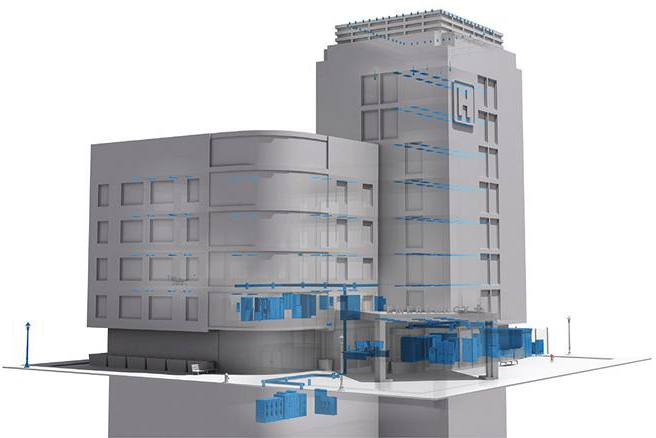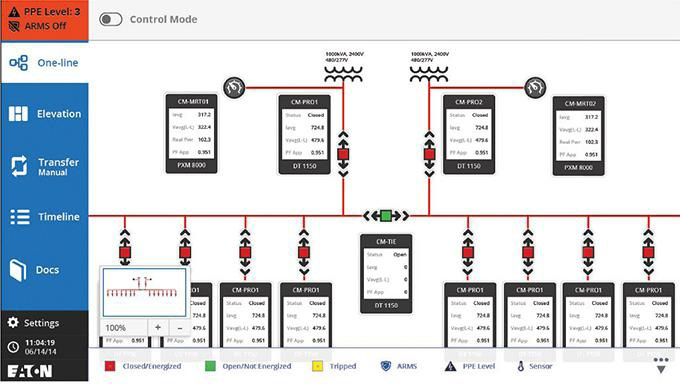Intelligent Power Starts With Accurate, Actionable Data
By Joel Benzing, Rob Griffin, James Lagree, And Lyle Sprinkle
Internet of Things connectivity for circuit protection lays the foundation for system-level intelligence.
In 2017, businesses spent an estimated $964 billion on connected hardware. By 2020, analysts indicate that an estimated 31 billion “things” will be connected to the internet. As the world becomes more digital, electrical infrastructure is rapidly evolving and offering new ways to support integrated, customizable, intelligent, and efficient buildings and processes.
The data provided by these billions of connected devices can be used in commercial and industrial settings to provide newfound system visibility and predictive diagnostics that can create fail-safe systems, enabling functionality that was not previously available.
Ultimately, these outcomes can yield significant improvements in productivity in throughput, dramatic increases in uptime, reduction in electricity consumption, and measurable quality improvements.
Intelligent power leverages this digital revolution and drives innovation through a combination of smart assets, connectivity, data science, and business models that are creating new interactions. At the heart of intelligent power are “things” that produce, collect, and process data. This data can help generate insights for better decision-making as more technologies have built-in connectivity for the Internet of Things (IoT).
By applying real-time monitoring and communications at the heart of an electrical system, end users can collect data, learn more about their systems, and generate actionable insights. Those users can then leverage that knowledge to optimize power usage, improve system continuity and uptime, and lower operational costs at water and wastewater treatment facilities. This type of digital connectivity can also exist on the manufacturing floor, within commercial buildings, across health care facilities, in the home, or on the electrical grid.
When it comes to the electrical system, there are powerful advantages to connectivity and intelligence for foundational electrical components, including circuit breakers. Circuit breakers are used in nearly every electrical system, and they perform a fundamental function — interrupting current flow in the case of an overload or short circuit. With the latest innovations, they are now also on the frontier of intelligent power management.
Traditionally, circuit breakers were electromechanical devices designed to protect conductors (insulated wires) by opening automatically before excessive temperatures caused damage. Decades of circuit breaker design, testing, and application knowledge are being applied to develop algorithms that provide new embedded intelligence in circuit breakers and revolutionize circuit protection with features more akin to a smartphone, while also supporting traditional safety functionality. In a building or on the factory floor, these circuit breakers support detailed levels of system visibility and enable predictive diagnostics, which translate into powerful system advantages including:
- Making higher levels of uptime possible through better connectivity and remote optimization of system parameters.
- Driving condition-based maintenance that’s more cost-effective and efficient than traditional approaches.
- Supporting enhanced safety — through an arc flash reduction maintenance system and visual indication of zone-selective interlocking (ZSI).
- Creating smart and connected equipment or extending and enhancing the capabilities of legacy equipment.

Intelligent and connected technologies are driving higher-level system visibility and predictive diagnostics.
Such power management technologies in circuit breakers can provide the real-time visibility needed to proactively mitigate unplanned downtime and manufacturing inefficiencies. This can have a major impact on the competitiveness of businesses, as studies show that the annual cost of unplanned downtime for manufacturers is in the range of $50 billion. Digitizing factories to create a unified network of intelligent and connected devices can drive actionable outcomes in preventive maintenance, training, production planning, quality, energy savings, and more.
Collecting And Processing Data
New intelligent circuit breakers contain more internal sensors to provide continuous monitoring and an accurate picture of circuit breaker and system status. Today, circuit breakers can monitor ambient and operating conditions, including length of service, temperature, current, number and severity of interruptions, event history, and voltage.
Additionally, new and powerful breaker health algorithms provide all the diagnostic indicators needed to monitor the status or health of an individual device. Through this innovative technology, facility and system operators can track the health of fundamental electrical system components in real time and over time.
Analysis can be performed through the algorithm in the trip unit to get a sense of the device and system health. This data can then be communicated to the building management system, facility control system, or the cloud. The real-time data can be further leveraged to support an electrical system that is integrated and automated with the overall facility or process.
Furthermore, these intelligent circuit breakers will provide a new level of insight on the devices that are connected to the power distribution system, including critical information that can be used for predictive maintenance of critical systems. Leveraging this actionable data, facilities can intervene proactively to perform critical maintenance before there is a failure, improving their productivity and cutting their operational costs.
Turning Data Into Intelligence
With cloud computing and digital factories, every piece of equipment that generates data can be securely linked to a vast set of web information. Well-defined goals and program objectives enable personnel to focus on specific aspects of collected data and analytics to maximize return on investment (ROI) and drive improvements that advance preventive maintenance, save energy, boost productivity, reduce or avoid downtime, and dramatically reduce costs. Over time, collected data from devices can provide trend information to improve new and existing electrical system architecture, drive new levels of reliability, and reduce maintenance.
From a remote management standpoint, cloud connectivity of facility data can enable powerful insights that improve operations. For example, management teams can be notified immediately of alarm notification remotely through cloud connectivity, reducing downtime, equipment damage, and related costs. Even small fluctuations in equipment performance can be used to predict failure and enable personnel to avoid downtime and equipment damage. More broadly, remote and decentralized access to real-time monitoring of equipment and building systems can:
- Keep personnel informed with critical data through a secure dashboard.
- Provide notifications and enable personnel to address issues remotely.
- Help spot energy usage anomalies and identify/enable personnel to adjust equipment.
- Enable a shift from reactive to preventive maintenance.
- Enhance safety by avoiding unnecessary, calendar-based maintenance of all breakers that could expose electricians to shock hazards.
- Provide the detailed forensic data to determine the root cause of power problems.
- Deliver long-term power and energy usage information needed to make smart capital investment decisions.
Further, the ability to monitor systems remotely can support compliance with industrial and governmental regulators — particularly in critical facilities. With electronic logs of energy usage and system data, creating reports becomes as easy as pressing a button.
Driving Actionable Outcomes: What Do We Hope To Learn?
- Data to target throughput increase.
- Diagnostics insights to reduce equipment stoppage and increase uptime.
- Performance data across multiple machines.
- Information to reduce energy consumption and costs.
- Predictive insights to determine when a process change is needed.
Conclusion
End users across nearly every industry are in a constant battle to meet challenging — and sometimes competing — demands. They are at the heart of an increasingly digital economy, and their success depends on “always on” power — yet they’re under constant pressure to reduce energy usage. They must balance aging infrastructure with constrained budgets and the desire to make systems smarter, safer, and more responsive than ever before.
There are powerful solutions to these challenges found within the connectivity and intelligence of foundational electrical components such as circuit breakers. Consider the application of intelligent circuit breakers installed in the data center of a Midwestern U.S. university. With built-in intelligence and communications, the circuit breakers provided critical new functionality in ways previously unimaginable.
The facility manager and maintenance staff are now able use the circuit breakers’ communications for remote operation — keeping personnel outside of the arc flash boundary to enhance safety. Meanwhile, the Ethernet-based communication enabled by the circuit breaker trip unit provides system-wide communications without the additional time and expense of dedicated wiring.

Embedded intelligence in circuit breakers can provide an accurate picture of system status.
Additionally, the intelligent circuit breakers are advancing maintenance and uptime by enabling troubleshooting and the ability to quickly identify the root cause of power system problems so that power can be quickly restored.
For example, a ground fault condition was recently detected at the data center, and the intelligent circuit breaker trip units alerted staff to the condition via new alarms. The data center staff was able to access current and historical power system data to identify and locate the problem before rapidly addressing the issue to restore power.
With the ability to set alarms and access historical data, the facility’s staff is able to identify and address power system issues without the need for extensive investigating and troubleshooting. The real-time and historical data analysis provided through the intelligent circuit breakers is not only helping the university respond to system faults and failures, but also it is allowing them to improve their maintenance operations by giving them the data to address system issues before an outage even occurs.
Whether it’s at the water/wastewater utility; for the electric or transportation grid; on the manufacturing floor; or within health care facilities, buildings, or the home; these intelligent and communicating electrical system building blocks generate the insights needed to help make smart decisions, each and every day.
About The Authors
Joel Benzing received his Bachelor of Science degree from North Carolina State. He has been with Eaton for over two decades in roles spanning engineering to product and marketing management for relays, motor control, and switchgear. He is currently the marketing manager focusing on meters and relays.
Rob Griffin has a Master of Business Administration from Carnegie Mellon University and a Bachelor of Science degree from Bucknell University. He has been with Eaton since 2003 in leadership roles spanning the manufacturing, supply chain, and marketing functions, and is now the global product line manager for molded case circuit breakers and air circuit breakers.
James Lagree received a Master of Science degree in electrical engineering from the University of Pittsburgh and a Bachelor of Science from Rochester Institute of Technology. He has been with Eaton since 1994 and is now a chief engineer for the Power Components Division. Jim has been a member of IEEE for 38 years and member of the IAS, PES, IE, and Engineering Management Societies. He is listed as an inventor on 27 patents.
Lyle Sprinkle holds a Master of Business Administration with an international marketing focus from the University of Texas at Dallas and an electrical engineering degree from Georgia Tech. Throughout his career, he has architected and brought numerous cutting-edge solutions to market around the globe in wireless applications, mobile computing, and networking spaces. Lyle is director of meters, relays, and IoT solutions in the Power Components Division at Eaton.
